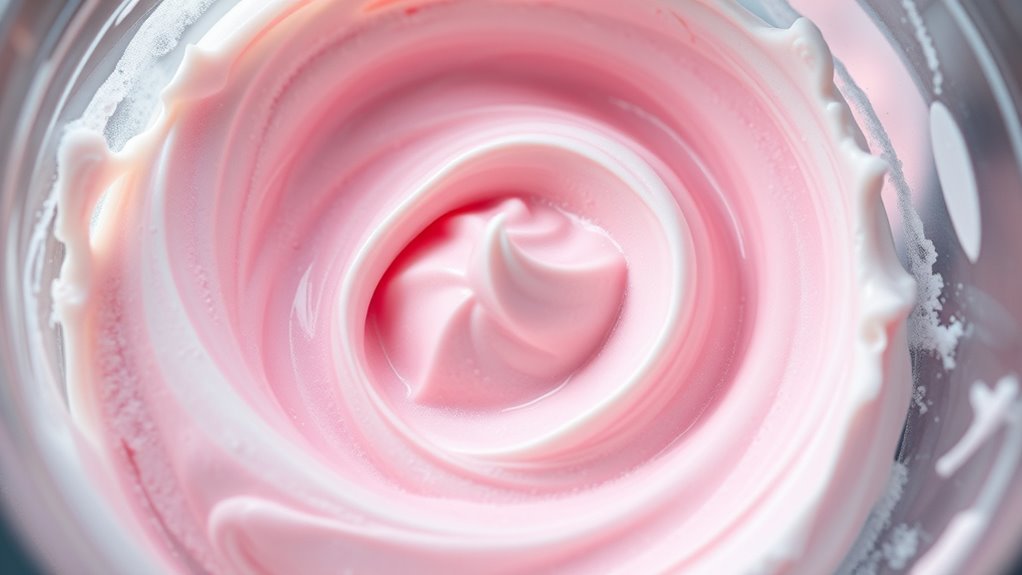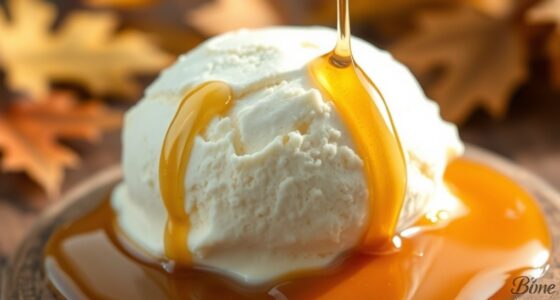Overrun is the amount of air you incorporate into ice cream during freezing, which directly affects its texture and volume. When air is whipped in, the ice cream becomes lighter, fluffier, and more aerated, giving it a smoother mouthfeel. If you add less air, the ice cream turns out denser and richer. Understanding how air influences ice cream can help you create just the right texture—keep exploring to learn more about the science behind overrun and its effects.
Key Takeaways
- Overrun is the amount of air incorporated into ice cream during freezing, affecting its texture and volume.
- Increased air (higher overrun) makes ice cream lighter and fluffier, while lower overrun results in denser, creamier texture.
- Dairy fat content influences how much air can be whipped into the mixture, with higher fat limiting overrun.
- Freezing methods, such as churning and rapid freezing, control how much air is trapped in the ice cream.
- Adjusting overrun levels allows manufacturers to create different ice cream textures, from dense to airy.

Overrun occurs when something exceeds its planned or intended capacity, often leading to overflow or congestion. In the world of ice cream, overrun specifically refers to the amount of air incorporated into the product during freezing, which affects both texture and volume. When making ice cream, you may notice that the final product is much lighter and fluffier than the mixture you started with. This is due to the air that’s whipped into the base during the freezing process. The amount of air, or overrun, can vary considerably depending on how the ice cream is produced and the techniques used, especially the freezing methods.
Overrun is the air whipped into ice cream during freezing, influencing texture and volume.
Understanding the dairy fat content is essential when considering overrun. Higher dairy fat content generally results in a creamier, richer texture, but it can also influence how much air can be incorporated. More fat tends to make the mixture thicker and more resistant to whipping air into it, which can limit overrun. Conversely, lower-fat ice creams are often designed to hold more air, leading to a lighter, more aerated final product. If you’re aiming for a dense, indulgent ice cream, you might prefer a higher dairy fat content with minimal overrun. But if you want a light, airy treat, adjusting the dairy fat and increasing overrun through specific freezing methods becomes essential.
Freezing methods play a critical role in controlling overrun. Traditional batch freezers, often used in artisanal ice cream production, allow more control over the amount of air added during freezing. These methods typically involve churning the mixture at a consistent temperature, which helps evenly incorporate air without compromising the creaminess. On the other hand, continuous freezers, commonly found in commercial settings, can produce higher overrun levels quickly by forcing air into the mixture during rapid freezing. The key is balancing the freezing speed and agitation to achieve the desired overrun without sacrificing texture. Faster freezing methods tend to trap more air, creating a lighter product, but they can also impact the dairy fat’s ability to emulsify, affecting overall creaminess.
Ultimately, understanding how dairy fat content interacts with freezing methods allows you to control overrun effectively. If you want a dense, velvety ice cream, choose techniques that limit overrun and focus on maintaining higher dairy fat levels. For a lighter, more voluminous ice cream, opt for freezing methods that encourage higher overrun, ensuring the mixture is whipped with enough air to achieve that airy consistency. By mastering the relationship between dairy fat, freezing methods, and overrun, you can create ice cream with the perfect texture tailored to your preferences. Additionally, incorporating air incorporation techniques can further help control the overrun level for desired results.
Frequently Asked Questions
How Does Overrun Affect Ice Cream Texture?
Overrun directly impacts ice cream texture by controlling air incorporation during freezing. Higher overrun means more air is whipped into the mixture, making the ice cream lighter and fluffier. This texture enhancement results in a softer, smoother feel, while lower overrun yields a denser, creamier product. You’ll notice that adjusting overrun lets you customize ice cream’s mouthfeel, giving it the perfect balance between creaminess and lightness.
Can Overrun Be Adjusted During Production?
Yes, you can adjust overrun during production by tweaking your machine calibration. Think of it as fine-tuning a musical instrument—you control the batch size and air incorporation to achieve the perfect harmony. By carefully monitoring and adjusting these settings, you guarantee the ice cream’s texture stays just right. Regular calibration allows you to respond to variations in ingredients or desired consistency, making your production process both flexible and precise.
What Are the Ideal Overrun Levels for Premium Ice Cream?
In ice cream manufacturing, the ideal overrun levels for premium ice cream typically range from 20% to 40%. You should focus on overrun control to maintain quality, as lower overrun makes the ice cream denser and richer, enhancing the premium experience. Adjustments during production can help, but maintaining consistent overrun levels guarantees your product stays smooth, flavorful, and appealing to discerning customers.
How Does Overrun Influence Ice Cream Flavor?
You might think overrun doesn’t affect flavor, but it actually plays a key role in flavor preservation. Higher overrun introduces more air, which can dilute the ice cream’s rich taste, making flavors less intense. Good air quality during production guarantees that the air added is clean and pure, helping to maintain the original flavor profile. So, controlling overrun is essential for delivering consistently flavorful ice cream.
Is Higher Overrun Always Better for Ice Cream Quality?
Higher overrun isn’t always better for ice cream quality. It can improve consistency and create a lighter texture, but if overrun is too high, it may cause air bubbles to become unstable, affecting the final product. You should regularly calibrate your equipment to maintain ideal overrun levels. Finding the right balance ensures your ice cream stays creamy and flavorful, rather than overly airy or flimsy.
Conclusion
Now that you know what overrun is and how air affects ice cream’s allure, you can confidently craft creamy creations. Remember, a perfect balance brings blissful bites, blending boldness with beauty. By understanding overrun, you’re empowered to enhance every scoop’s softness and sweetness. So, savor the science, seize the science’s secrets, and serve sensational, smooth, and sensationally satisfying ice cream every time. Your delightful desserts will definitely dazzle and delight!









